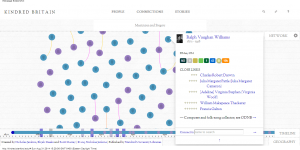The Kindred Britain project aims to create a database of important people, mainly in Britain, but also from around the world, and to catalog family connections between them all. The site accomplishes this mainly through the use of prosopography and visual networking. Every person in the network has a summary of their family and their careers, a timeline of major events in their lives, and their connections, by blood and by marriage, to other people in the network.

The connections are the main focus of this project, and so a lot of work has gone into the visual networking element of DH. Putting any two people together will result in the database tracing a path through family ties to connect the two people together.
The project’s goal is to represent English history as a sort of family affair, drawing connections between kings and poets, actors and scientists, people from all walks of life who may have lived centuries apart, or may have been born the same day. The focus on connections as the goal of Kindred Britain dictates the use of visual networking as the main method used to display the information.
The website offers many preset scenarios to new users, including connections between famous rivals, authors and the subjects of their writings, and people buried in neighboring graves. These springboard ideas spark users to ask their own interesting questions and do deeper research into the intricate connections between major historical figures.

Or, users can ask slightly less scholarly and more frivolous questions like “What’s the connection between William Shakespeare and Arnold Schwarzenegger?” The database can answer those just the same.
Overall, the Kindred Britain project is a great example of the goals of the Digital Humanities: taking rather obscure and loosely organized data, and putting it together in a way that is accessible to the public.